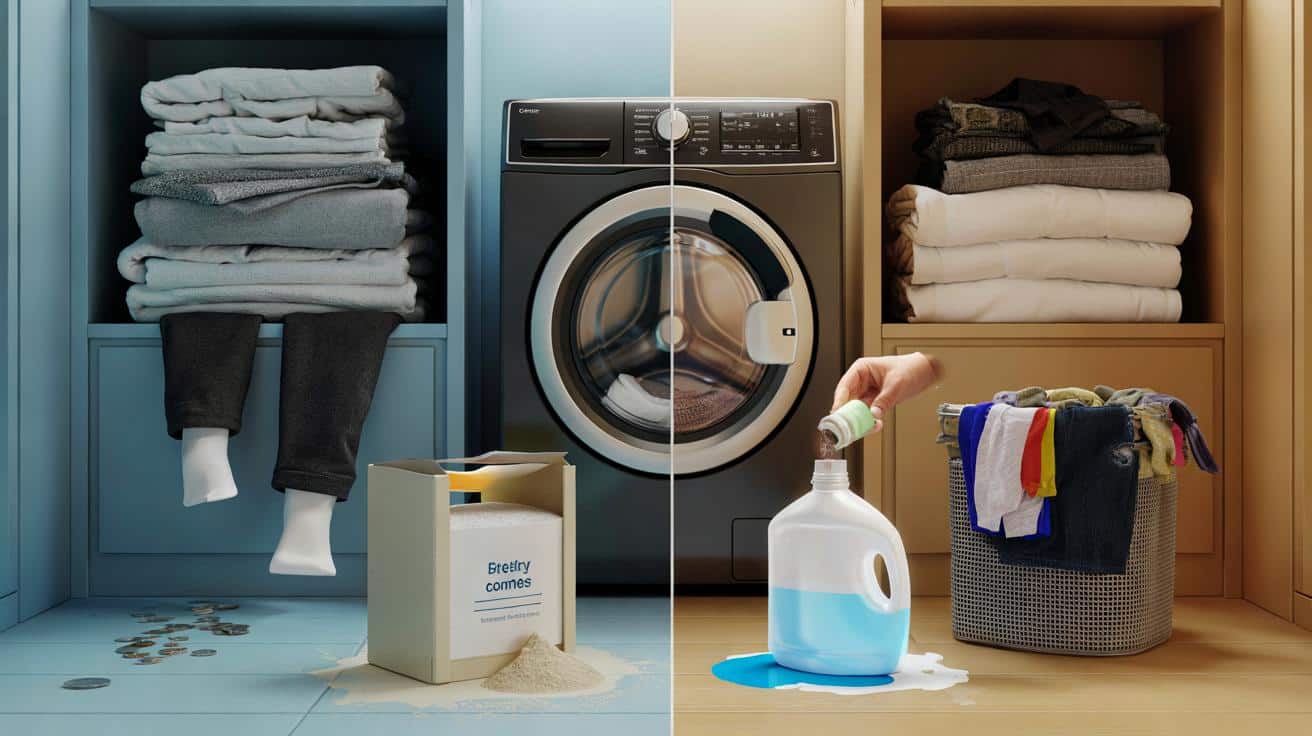Small choices in your basket shape colour, softness and costs far more than you think.
As cooler, wetter days push more knits and bedding into the drum, the wrong detergent and dose can flatten colours, roughen fibres and inflate bills. New data from consumer testers and appliance engineers points to a simple fix: match format to fabric, soil and temperature, not to the loudest scent or the glossiest bottle.
The weekly mistake that dulls your wash
Many shoppers swap brands with every promotion and judge cleaning by foam and fragrance. Both are poor guides. Modern machines need low suds to rinse well. Strong perfume often masks residues rather than proof clean fibres.
Overdosing is the other trap. Extra liquid or a second pod rarely boosts stain removal, but it does leave film on towels and clogs drawers. That film holds on to odour, stiffens cotton and shortens the life of elastics. If you run five loads a week and overdose by a quarter, you may spend £35–£60 more a year for dingier results.
Clean laundry is mostly chemistry and temperature: right enzymes, right dose, enough time, proper rinse. Foam and perfume are theatre.
Powder, liquid or pods: what actually cleans better
Powder for whites and grime
Powder carries oxygen bleach and optical brighteners that lift grey from white cotton at 40 °C and above. It shines on sheets, school shirts and workwear with ground-in soil. It stores well, needs no added preservatives and performs in hard water. Cost per wash is often the lowest, around £0.12–£0.20 when measured correctly.
It can be less kind to wool, silk and dark synthetics on cold, short cycles. Granules may not dissolve fully at 20–30 °C if the drawer is gummed up or the water pressure is low, leaving specks on black leggings and knitwear.
Liquid for colours and delicate fibres
Liquid dissolves fast, even at 30 °C, and spreads enzymes evenly through fibres. That makes it a safer bet for dark denim, technical sports tops and mixed-colour loads. It avoids the chalky streaks that powders can leave on cold programmes. Expect to pay a little more per wash, commonly £0.18–£0.28 if dosed by water hardness and soil level.
Preservatives and fragrance allergens in some formulas can irritate sensitive skin. Liquids usually lack oxygen bleach, so they struggle to de-yellow pillowcases or remove stubborn tea tannins without a separate booster.
Pods for convenience, not for every drum
Pods deliver a fixed dose in seconds and keep cupboards tidy. For busy flats with small drums, that convenience is tempting. Yet fixed dosing is a blunt tool. A single pod may overdose a 4 kg quick wash and underdose a 9 kg family load. The film can fail to dissolve on cold eco cycles, leaving jelly-like residue on cuffs or in the door seal.
Pods also push up costs. A mid-range pack often works out at £0.30–£0.45 per wash. For skin-prone households, the concentrated surfactant blend can be harsher on hands and necklines.
| Format | Best for | Average cost per wash | Temperature sweet spot | Skin notes |
|---|---|---|---|---|
| Powder | Whites, heavy soil, hard water | £0.12–£0.20 | 40–60 °C | Fewer preservatives; may leave residue on cold cycles if overdosed |
| Liquid | Colours, delicates, quick cycles | £0.18–£0.28 | 30–40 °C | Watch for fragrance allergens; gentle on fibres |
| Pods | Small, routine loads when speed matters | £0.30–£0.45 | 40 °C standard cycles | High surfactant concentration; store away from children |
For white cotton at 40 °C, powder with oxygen bleach tends to out-clean liquid and pods at a lower price per wash.
Your quick match by need
- White bedding, shirts and towels: pick a non-bio powder with oxygen bleach and run 40–60 °C.
- Dark denim, colour mixes and synthetics: use a colour-safe liquid at 30–40 °C to protect dyes.
- Wool and silk: use a wool-safe liquid without enzymes; switch off spin boost to protect fibres.
- Busy weeknight top-ups: pods can help on standard 40 °C cycles when the drum is half-full.
How to stop residue, rough towels and rising bills
Measure by hardness and soil
Use the lower end of the dose for soft water and lightly soiled clothes. Increase toward the upper guide for hard water or visible dirt. Your water supplier publishes hardness by postcode. Mark the right dose on your cap with a permanent pen. This alone cuts waste and improves rinsing.
Load size and time matter
Fill the drum to a loose 75% so items can tumble. A stuffed drum blocks rinsing and traps detergent. Short eco cycles save energy only when the load is lightly soiled. For muddy kit, pick a longer 40 °C cotton cycle to give enzymes time to work.
Keep the machine clean
Run a monthly 60 °C maintenance wash with powder. Pull out the drawer and scrub the siphons. Wipe the door seal. A clean path helps powders dissolve, prevents black slime and reduces odour transfer to fresh laundry.
Right dose, right cycle, right format: three moves that brighten cotton, soften towels and shave pounds off your annual spend.
Autumn laundry playbook
Rainy weeks mean heavier fabrics and slower drying. Spin towels at 1200–1400 rpm to shorten airing time. Switch to powder for bedding to keep whites crisp under low sunlight. For knitwear, use a mesh bag, a wool-safe liquid and a gentle 30 °C programme. Dry flat on a rack to prevent sagging.
If pods are your fallback, set 40 °C and a standard cycle to help the film dissolve. Always keep pods in a latch box high up; accidental exposures rise when heating goes on and children spend more time indoors.
What testers looked for this season
Independent testers ran side-by-side loads on tomato, tea, sebum and mud at 30 °C and 40 °C. Powders scored highest on tea and body oils at 40 °C. Liquids led on colour retention at 30 °C. Pods matched liquids on fresh stains but slipped on cold quick cycles, mostly due to partial dissolution.
Fragrance longevity varied widely. Strong scent at the door didn’t predict odour control after a gym session. Rinsing quality and proper drying mattered more. A half-dose of powder on a long 40 °C cotton cycle often smelled cleaner after wear than a scented quick wash.
Extra help if you have sensitive skin
Choose fragrance-free non-bio formulas and run an extra rinse on babywear, gym tops and pillowcases. Avoid fabric softener on towels and sports fabrics; softeners reduce absorbency and lock perfumes next to the skin. If redness persists, try switching from liquid to powder, reduce dose by 10%, and raise the rinse water level if your machine allows it.
A simple cost check you can try tonight
Weigh a week’s detergent with a kitchen scale. Compare the label’s recommended grams or millilitres for your water hardness and load size. If you are 20% over each time and you wash five loads weekly, trimming your dose could save £25–£50 a year without touching cleanliness. That pays for a new set of towels or a winter throw.
One final adjustment changes results fast: choose your format by fabric and temperature, not by scent. Powders for bright whites at 40–60 °C, liquids for colour care at 30–40 °C, pods only when convenience is the priority and the cycle is warm enough to dissolve the film. Your wardrobe will look better by the weekend, and your meter will spin a little slower.








